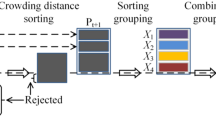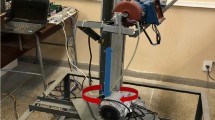Abstract
In the joint space, calculating the jerk-optimized trajectory of a redundant space manipulator is a significant issue in motion planning. The third derivative of desired joint trajectory position, known as a jerk, influences the smooth and effective movement of the manipulator. Using the conventional approach for multi-parameters selection, it is challenging to get an optimal solution. This can be taken care of by using an advanced optimization technique, grey wolf optimization which provides such search capabilities having the potential to produce optimum results. Therefore, to implement jerk-optimized motion planning, this work presents an approach based on grey wolf optimization, constrained by the joint inter-knot parameters in the joint space. It is expected that the proposed approach will impart the lowest joint jerk in comparison with other existing approaches like the genetic algorithm and particle swarm optimization. Consequently, minimal deviation of the joint trajectory can be observed at each joint. For various time intervals, minimal jerk values of the mean, maximum, and minimum for all joint angles are experienced compared to the genetic algorithm approach. Hence, smooth joint trajectories are generated for each joint, enabling the end-effector to move the desired pose with minimal jerk enhancing the stability of the manipulator.





Similar content being viewed by others
Availability of Data and Material
Not applicable.
Code Availability
Not applicable.
Abbreviations
- \(H_{b} ,H_{bm}\) :
-
Inertia matrix and coupling inertia matrix for robot base, respectively
- \(\vec{\theta }_{1} ,\vec{\theta }_{2} , \ldots ,\vec{\theta }_{8}\) :
-
Joint angle vector of the manipulator
- \(y_{eo}\), \(y_{ed}\), \(\theta^{e}\) :
-
Starting, desired pose, orientation of end-effector, respectively
- \(r_{o} ,r_{e}\) :
-
Position vector of the centroid of robot base and end-effector, respectively
- \(d_{c}\) :
-
Initial pose of manipulator base
- \(\dot{\phi }\), \(\dot{\theta }\) :
-
Angular velocity of the base and effector, respectively
- \(\dot{T}_{e}\), \(\dot{p}\) :
-
Translational and joint velocity of end effector, respectively
- \(\psi\) :
-
Euler angles
- \(\varsigma\), \(\tau^{ * }\) :
-
Normalized time, real time of jth trajectory segment
- \(a_{i}\) :
-
Position vector from joint \(j_{i}\) to mass centre of link (\(c_{i}\))
- \(b_{i}\) :
-
Position vector from mass centre of link (\(c_{i}\)) to joint \(j_{i + 1}\)
- \(\alpha ,\beta ,\delta\) :
-
Different layers of grey wolves
- \(\vec{A}_{p}\) :
-
Optimal position of grey wolves with optimized fitness value
- \(t\) :
-
Total number of iterations
- \(\vec{X}(t)\), \(\vec{X}(t + 1)\), \(\vec{X}_{w} (t)\) :
-
Position of first grey wolf, denotes position of next grey wolves after (t + 1) iterations, position of \(\alpha ,\beta ,\delta\) grey, wolves, respectively
- \(\vec{N},\vec{P}\) :
-
Vectors for updated position of grey wolves
- \(\vec{y}_{1} ,\vec{y}_{2}\) :
-
Random vectors in range of [0, 2]
- \(\vec{n}\) :
-
Vectors in range of [0, 5]
- \(\vec{X}_{\alpha } ,\vec{X}_{\beta } ,\vec{X}_{\delta }\) :
-
Updated position of \(\alpha ,\beta ,\delta\) grey wolves after hunting
- \(A_{\alpha }\), \(A_{\beta }\), \(A_{\delta }\) :
-
Optimal position for \(\alpha ,\beta ,\delta\) grey wolves after hunting
- \(\dot{u}_{c} ,\ddot{u}_{c}\) :
-
Velocity and acceleration of each joint, respectively
- GWO:
-
Grey wolf optimization
- GA:
-
Genetic algorithm
- GJM:
-
Generalized Jacobian matrix
- EDM:
-
Enhanced disturbance map
- BPP:
-
Bidirectional path planning
- PIW:
-
Path independent workspace
- RNS:
-
Reaction null space
- HDC:
-
Hybrid dynamic coupling
- OTPJS:
-
Optimum trajectory planning in joint space
- PDW:
-
Path dependent workspaces
- DOF:
-
Degree of freedom
- PSO:
-
Particle swarm optimization
- OTG:
-
Optimal trajectory generation
References
Shrivastava, A.; Dalla, V.K.; Dal, P.N.: Space debris manipulation by cooperative redundant planar robots with minimized trajectory error. Arab. J. Sci. Eng. 2, 1–8 (2022)
Fang, Y.; Qi, J.; Hu, J.; Wang, W.; Peng, Y.: An approach for jerk-continuous trajectory generation of robotic manipulators with kinematical constraints. Mech. Mach. Theory 1(153), 103957 (2020)
Zhang, Z.; Ge, S.S.: Partial feedback linearization control of space flexible-link manipulator with geometric nonlinearity. In: 2014 IEEE International Conference on Information and Automation (ICIA), pp. 1102–1107. IEEE (2014)
Gasparetto, A.; Boscariol, P.; Lanzutti, A.; Vidoni, R.: Trajectory planning in robotics. Math. Comput. Sci. 6(3), 269–279 (2012)
Freeman, P.: Minimum jerk trajectory planning for trajectory constrained redundant robots. Washington University, St. Louis (2012)
Gasparetto, A.; Boscariol, P.; Lanzutti, A.; Vidoni, R.: Path planning and trajectory planning algorithms: a general overview. In: Carbone, G.; Gomez-Bravo, F. (Eds.) Motion and Operation Planning of Robotic Systems, pp. 3–27. Springer, Berlin (2015)
Lu, S.; Ding, B.; Li, Y.: Minimum-jerk trajectory planning pertaining to a translational 3-degree-of-freedom parallel manipulator through piecewise quintic polynomials interpolation. Adv. Mech. Eng. (2020). https://doi.org/10.1177/1687814020913667
Zhang, F.; Fu, Y.; Wang, S.: An adaptive variable structure control of the robot satellite system with floating base in Cartesian space. Proc. Inst. Mech. Eng. Part C J. Mech. Eng. Sci. 230(18), 3241–3252 (2016)
Liu, H.; Lai, X.; Wu, W.: Time-optimal and jerk-continuous trajectory planning for robot manipulators with kinematic constraints. Robot. Comput. Integr. Manuf. 29(2), 309–317 (2013)
Yoshida, K.; Umetani, Y.: Control of space manipulators with generalized Jacobian matrix. In: Xu, Y.; Kanade, T. (Eds.) Space Robotics: Dynamics and Control, pp. 165–204. Springer, Boston (1993)
Dalla, V.K.; Pathak, P.M.: Curve-constrained collision-free trajectory control of hyper-redundant planar space robot. Proc. Inst. Mech. Eng. Part I J. Syst. Control Eng. 231(4), 282–298 (2017)
Sagara, S.; Taira, Y.: Digital control of space robot manipulators with velocity type joint controller using transpose of generalized Jacobian matrix. Artif. Life Robot. 13(1), 355–358 (2008)
Yan, L.; Yuan, H.; Xu, W.; Hu, Z.; Liang, B.: Generalized relative Jacobian matrix of space robot for dual-arm coordinated capture. J. Guidance Control Dyn. 41(5), 1202–1208 (2018)
Giordano, A.M.; Ott, C.; Albu-Schäffer, A.: Coordinated control of spacecraft’s attitude and end-effector for space robots. IEEE Robot. Autom. Lett. 4(2), 2108–2115 (2019)
Cheng, Z.H.; Minghe, J.I.; Yechao, L.I.; Zongwu, X.I.; Hong, L.I.: Hybrid task priority-based motion control of a redundant free-floating space robot. Chin. J. Aeronaut. 30(6), 2024–2033 (2017)
Nakamura, Y.; Mukherjee, R.: Nonholonomic path planning of space robots via bi-directional approach. In: Proceedings of the IEEE International Conference on Robotics and Automation, pp. 1764–1769. IEEE (1990)
Luo, J.; Zong, L.; Wang, M.; Yuan, J.: Optimal capture occasion determination and trajectory generation for space robots grasping tumbling objects. Acta Astronaut. 1(136), 380–386 (2017)
Minghe, J.I.; Cheng, Z.H.; Yechao, L.I.; Hong, L.I.: Analysis of reaction torque-based control of a redundant free-floating space robot. Chin. J. Aeronaut. 30(5), 1765–1776 (2017)
Zhang, X.; Liu, J.; Gao, Q.; Ju, Z.: Adaptive robust decoupling control of multi-arm space robots using time-delay estimation technique. Nonlinear Dyn. 100(3), 2449–2467 (2020)
Dalla, V.K.; Pathak, P.M.: Trajectory tracking control of a group of cooperative planar space robot systems. Proc. Inst. Mech. Eng. Part I J. Syst. Control Eng. 229(10), 885–901 (2015)
Shrivastava, A.; Dalla, V.K.: Failure control and energy optimization of multi-axes space manipulator through genetic algorithm approach. J. Braz. Soc. Mech. Sci. Eng. 43(10), 1–7 (2021)
Fang, Y.; Hu, J.; Liu, W.; Shao, Q.; Qi, J.; Peng, Y.: Smooth and time-optimal S-curve trajectory planning for automated robots and machines. Mech. Mach. Theory 1(137), 127–153 (2019)
Morlock, M.; Bajrami, V.; Seifried, R.: Trajectory tracking with collision avoidance for a parallel robot with flexible links. Control Eng. Pract. 1(111), 104788 (2021)
Chen, D.; Zhang, Y.: Minimum jerk norm scheme applied to obstacle avoidance of redundant robot arm with jerk bounded and feedback control. IET Control Theory Appl. 10(15), 1896–1903 (2016)
Damaševičius, R.; Maskeliūnas, R.; Narvydas, G.; Narbutaitė, R.; Połap, D.; Woźniak, M.: Intelligent automation of dental material analysis using robotic arm with Jerk optimized trajectory. J. Ambient Intell. Humaniz. Comput. 11(12), 6223–6234 (2020)
Xiao, P.; Ju, H.; Li, Q.: Point-to-point trajectory planning for space robots based on jerk constraints. Rev. Sci. Instrum. 92(9), 094501 (2021)
Dalla, V.K.; Pathak, P.M.: Impedance control in multiple cooperative space robots pulling a flexible wire. Proc. Inst. Mech. Eng. Part C J. Mech. Eng. Sci. 233(6), 2190–2205 (2019)
Yang, S.; Wen, H.; Jin, D.: Trajectory planning of dual-arm space robots for target capturing and base manoeuvring. Acta Astronaut. 1(164), 142–151 (2019)
Dai, C.; Lefebvre, S.; Yu, K.M.; Geraedts, J.M.; Wang, C.C.: Planning jerk-optimized trajectory with discrete time constraints for redundant robots. IEEE Trans. Autom. Sci. Eng. 17(4), 1711–1724 (2020)
Dubowsky, S.; Torres, M.A.: Path planning for space manipulators to minimize spacecraft attitude disturbances. In: Proceedings of IEEE International Conference on Robotics and Automation, vol. 3, pp. 2522–2528. IEEE (1991)
Solovey, K.; Kleinbort, M.: The critical radius in sampling-based motion planning. Int. J. Robot. Res. 39(2–3), 266–285 (2020)
Wang, M.; Luo, J.; Walter, U.: A non-linear model predictive controller with obstacle avoidance for a space robot. Adv. Space Res. 57(8), 1737–1746 (2016)
Li, Y.; Hao, X.; She, Y.; Li, S.; Yu, M.: Constrained motion planning of free-float dual-arm space manipulator via deep reinforcement learning. Aerosp. Sci. Technol. 1(109), 106446 (2021)
Xu, W.; Liu, Y.; Liang, B.; Xu, Y.; Qiang, W.: Autonomous path planning and experiment study of free-floating space robot for target capturing. J. Intell. Robot. Syst. 51(3), 303–331 (2008)
Dalla, V.K.; Pathak, P.M.: Docking operation by multiple space robots for minimum attitude disturbance. Int. J. Model. Simul. 38(1), 38–49 (2018)
Hatta, N.M.; Zain, A.M.; Sallehuddin, R.; Shayfull, Z.; Yusoff, Y.: Recent studies on optimisation method of grey wolf optimiser (GWO): a review (2014–2017). Artif. Intell. Rev. 52(4), 2651–2683 (2019)
Mirjalili, S.; Mirjalili, S.M.; Lewis, A.: Grey wolf optimizer. Adv. Eng. Softw. 1(69), 46–61 (2014)
Gupta, S.; Deep, K.: A novel random walk grey wolf optimizer. Swarm Evol. Comput. 1(44), 101–112 (2019)
Gohil, B.N.; Patel, D.R.: An improved grey wolf optimizer (iGWO) for global engineering optimization. J. Comput. Theor. Nanosci. 17(1), 359–362 (2020)
Chen, X.; Qin, S.: Kinematic modeling for a class of free-floating space robots. IEEE Access. 29(5), 12389–12403 (2017)
Saramago, S.F.; Steffen, V.: Trajectory modeling of robot manipulators in the presence of obstacles. J. Optim. Theory Appl. 110(1), 17–34 (2001)
Cristofaro, A.; Salaris, P.; Pallottino, L.; Giannoni, F.; Bicchi, A.: On the minimum-time control problem for differential drive robots with bearing constraints. J. Optim. Theory Appl. 173(3), 967–993 (2017)
Saremi, S.; Mirjalili, S.Z.; Mirjalili, S.M.: Evolutionary population dynamics and grey wolf optimizer. Neural Comput. Appl. 26(5), 1257–1263 (2015)
Emary, E.; Zawbaa, H.M.; Grosan, C.; Hassenian, A.E.: Feature subset selection approach by gray-wolf optimization. In: Afro-European conference for industrial advancement, pp. 1–13. Springer, Cham (2015)
Li, J.; Yang, F.: Task assignment strategy for multi-robot based on improved grey wolf optimizer. J. Ambient Intell. Humaniz. Comput. 11(12), 6319–6335 (2020)
Man, K.F.; Tang, K.S.; Kwong, S.: Genetic algorithms: concepts and applications [in engineering design]. IEEE Trans. Ind. Electron. 43(5), 519–534 (1996)
Funding
This article author(s) received no financial assistance for its research, writing, or publication.
Author information
Authors and Affiliations
Corresponding author
Ethics declarations
Conflict of interest
The authors state that they have no known conflicting financial interests or personal ties that may have impacted the work reported in this study.
Ethics Approval
The authors state that they do not have any conflicts of interest. The authors did not collect information from humans or animals. The data utilized in this study came from publicly available sources.
Consent to Participate
Not applicable.
Consent for Publication
Not applicable.
Appendix
Appendix
Rights and permissions
About this article
Cite this article
Shrivastava, A., Dalla, V.K. Jerk Optimized Motion Planning of Redundant Space Robot Based on Grey-Wolf Optimization Approach. Arab J Sci Eng 48, 2687–2699 (2023). https://doi.org/10.1007/s13369-022-07002-1
Received:
Accepted:
Published:
Issue Date:
DOI: https://doi.org/10.1007/s13369-022-07002-1




